Thorn Park on the island garden

CUCAMELONS, ZUCCHINI AND BEANS GOING STRAIGHT INTO THE KITCHEN
a cook's garden
the abundant produce
in thorn park
on the island's garden
is the foundation of
david hay's
fabulous seasonal cooking
in david's own words
Michael and I purchased the Kangaroo Island property nearly 20 years ago as a holiday “shack” to replace our previous one on York Peninsular. It was meant to be a temporary house whilst we located the perfect site to build the holiday house of our dreams! Funny how things happen, we fell in love with the site, and the house had some redeeming features. We did a quick makeover to make it more “us”.
The house is situated high above the village of Penneshaw; on a very steep slope, with great views over the village and surrounding countryside; it has a very rural feel. But, even though the house is on half an acre, we had no real control over future development. We lusted after the 2.5-acre block in front of us, but the owner of some forty years, did not want to sell. The house was a small kit home. The redeeming features were that it was built in white ‘Colour Bond’ – and most rooms faced north. There was a small, fenced area that had a couple of tiny lawns, lots of agapanthus and lavender and little else. The previous owners had built a few dry-stone walls and done some stone paving.
As we let the house to others when we were not there, we decided to add a new “wing” with a master bedroom, bathroom and dressing room/storeroom. The old master bedroom became a small study/library.
We extended the fencing and added more plantings to anchor the house to the landscape.
We have always had a few things that make gardening a little difficult. Dozens of Tamar Wallabies and kangaroos, plus echidnas and goannas. The area is also mainly treed with the ‘Drooping Sheoak’ (Allocasuarina verticillate Casuarinacea) and not the best plant for companion planting. However, this is one of the main feeding areas for the endangered Glossy-black Cockatoos.
The only thing that grew in abundance was “Acacia Paradoxa”, better known as “Bugger Bush”! It’s all prickles and thorns and very, very volatile in a bush fire. Sadly, the wrens love to nest in it. Because of the ‘fuel factor’ in a bush fire, we had no choice but to remove these plants close to the house,
Miracles happen however and twelve years ago, we were able to purchase the 2.5 acres in front of the house and we then embarked on a very extensive revegetation of native plants to complement the casuarinas.
The local “Landscape SA Board” runs an amazing nursery that supplies tube stock for people wanting to revegetate so – we purchased lots of correas, banksias, xanthorroeas, melaleucas, bursaria spinosas; and our most loved of all, Orthrosanthus multiforus, or “Morning Flag”. This the native blue iris – the ‘roos and wallabies never eat them!
It’s a battle of wits between our loved wildlife and plants!click here
twenty years in the making
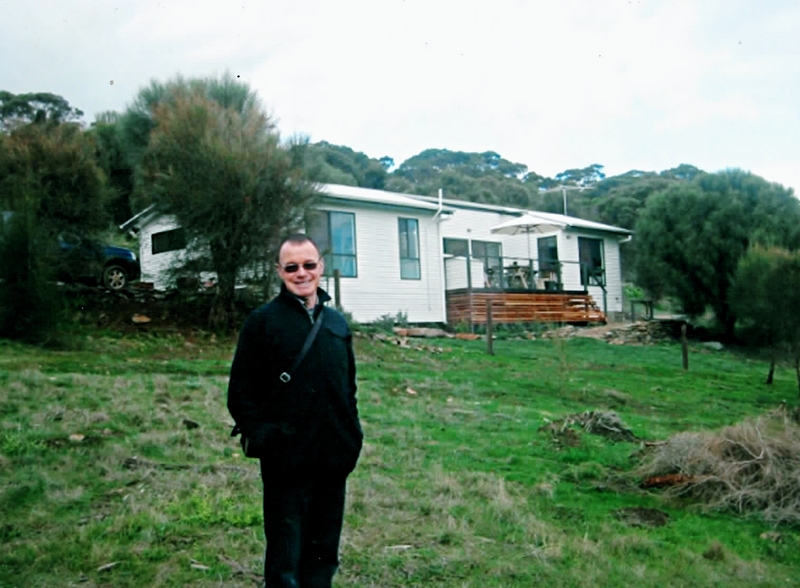
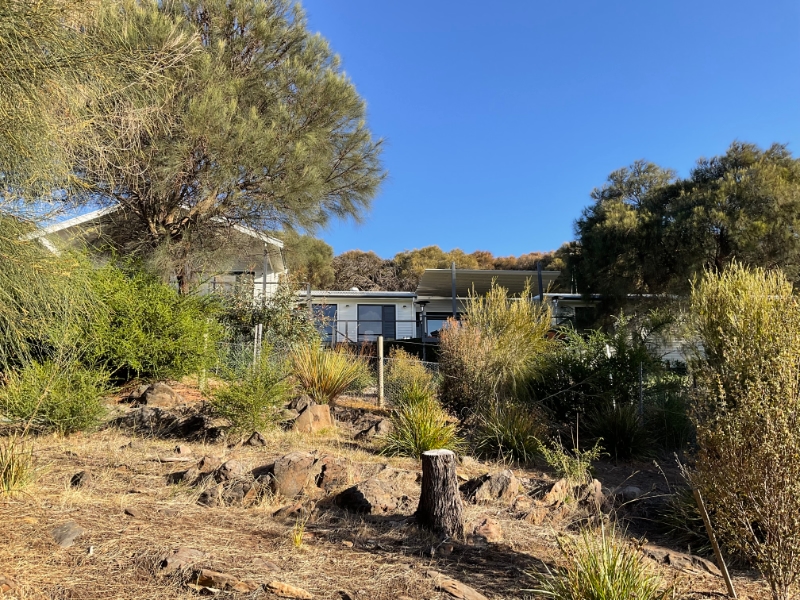
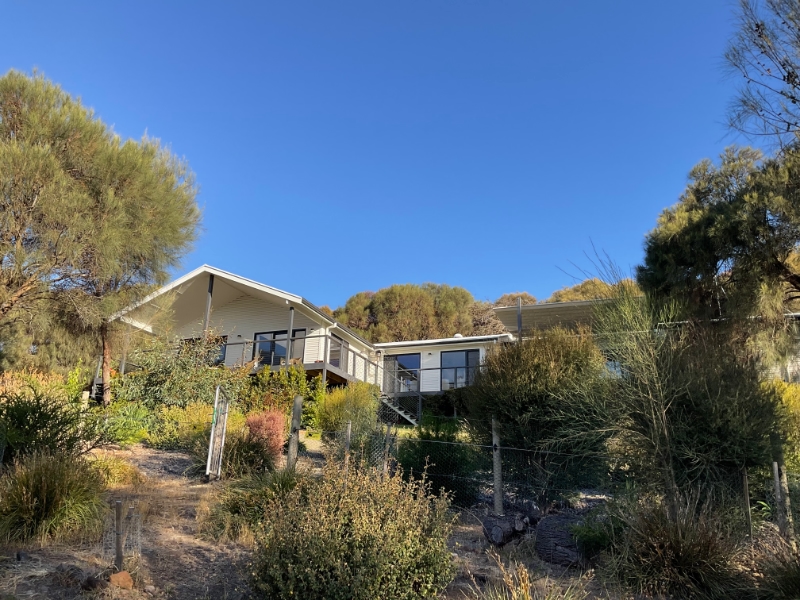
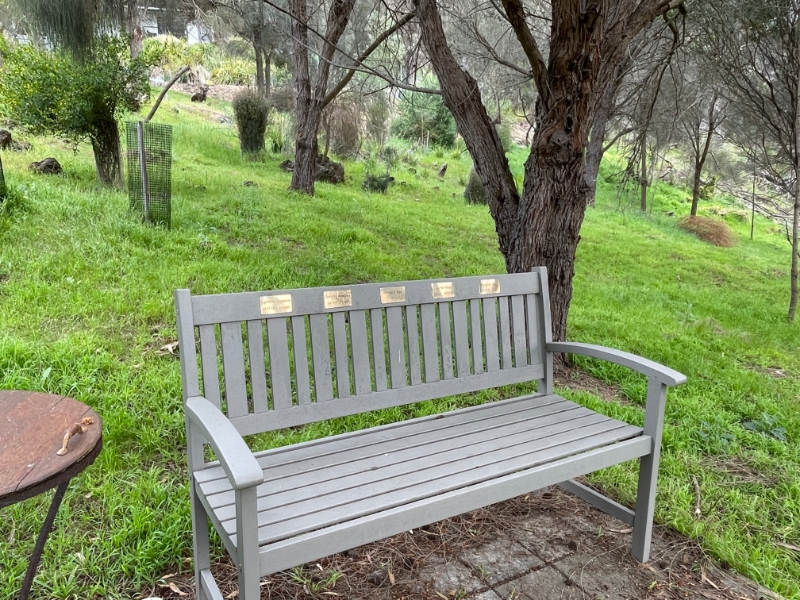
AS WELL AS THE MOTHERS OF TWO OF THEIR CLOSEST FRIENDS, BOTH CALLED DOROTHY
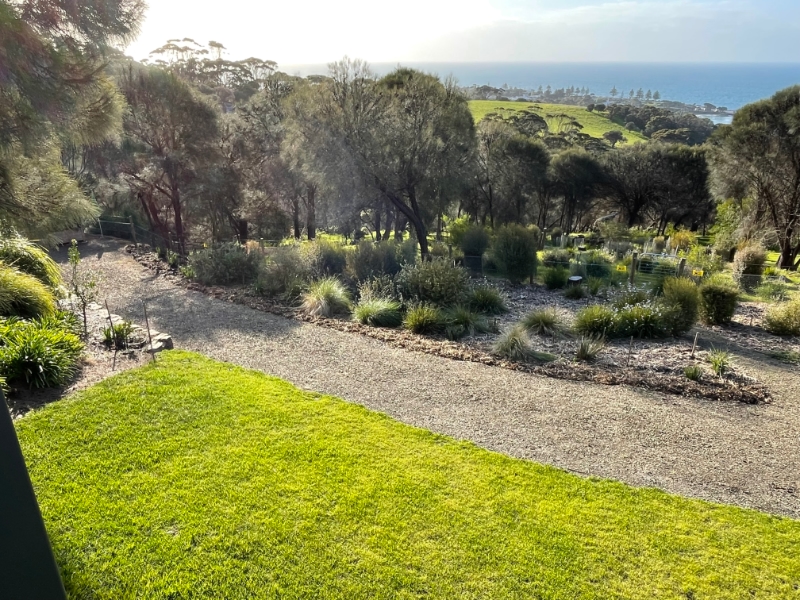
VILLAGE AND HARBOR OF PENNESHAW IN THE BACKGROUND
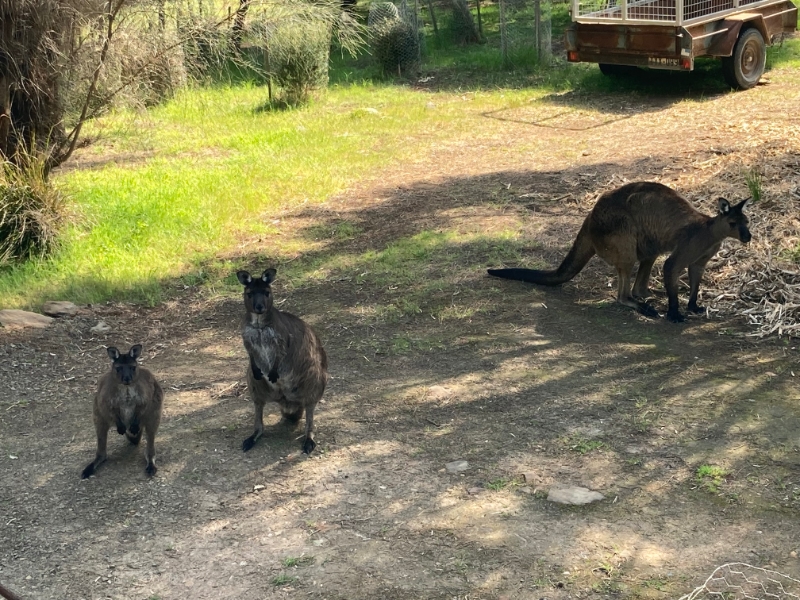
THORN PARK on the island
quick links
Subscribing to our newsletter is an excellent
way of staying in touch.
abundance
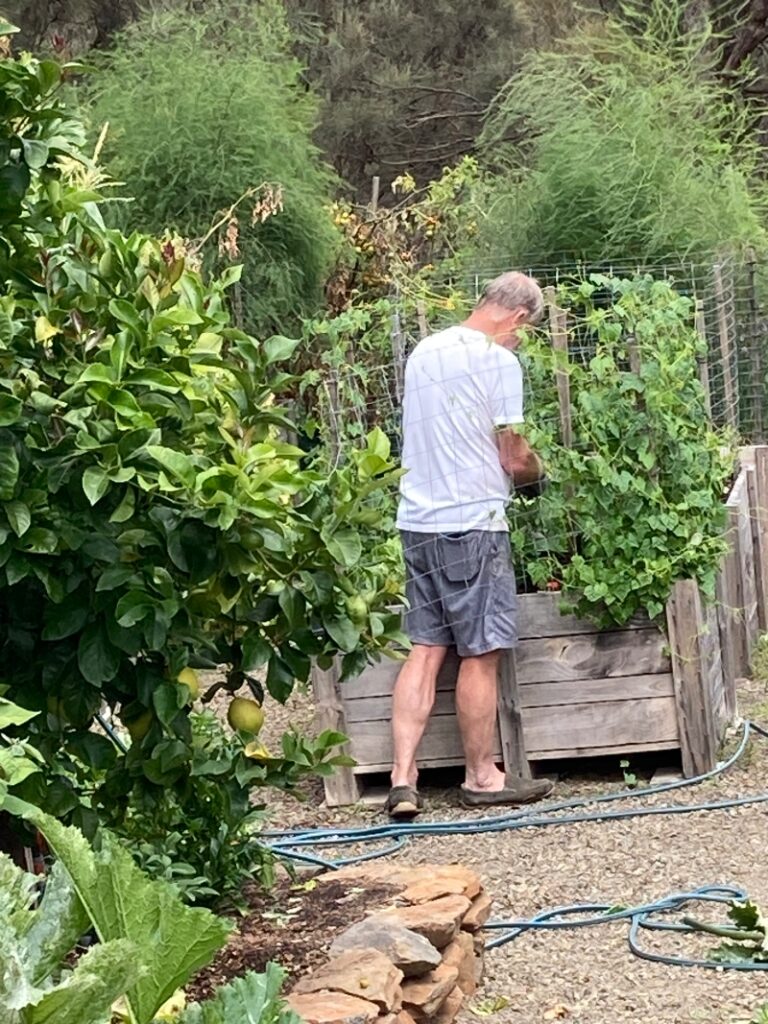
David Hay at work in the garden

“I BELIEVE DAVID HAY IS ONE OF AUSTRALIA’S FINEST CHEFS WITH AN ATTENTION TO DETAIL THAT STARTS WITH PICKING THE PRODUCE WORKING WIH PROTEIN SUPPLIERS AND SELECTING THE PERFECT PLATE FOR PRESENTATION”
and then came covid
Come “Covid”, and our lives changed! We had just arrived for a three-week vacation; and within a week “the lock down” happened. We had put our large Clare Valley rural property on the market a few weeks before. We thought this would enable us to buy something smaller in Clare, and then to spend our time between both areas. After all, we had lived in the Clare Valley for nearly 35 years!
We spent the lockdown on the island and the longer we stayed, the less we wanted to leave!
We negotiated the sale of ‘Clare’ over many months (‘interstate buyers’ who ended up buying it, sight unseen) and then we planned some much-needed renovations on the island property, to make the “shack” into a home.
What was flagged as a small renovation and extension, ended up being a total rebuild; and yet another Bed & Breakfast: “Thorn Park Mark 3”.Some people never learn!
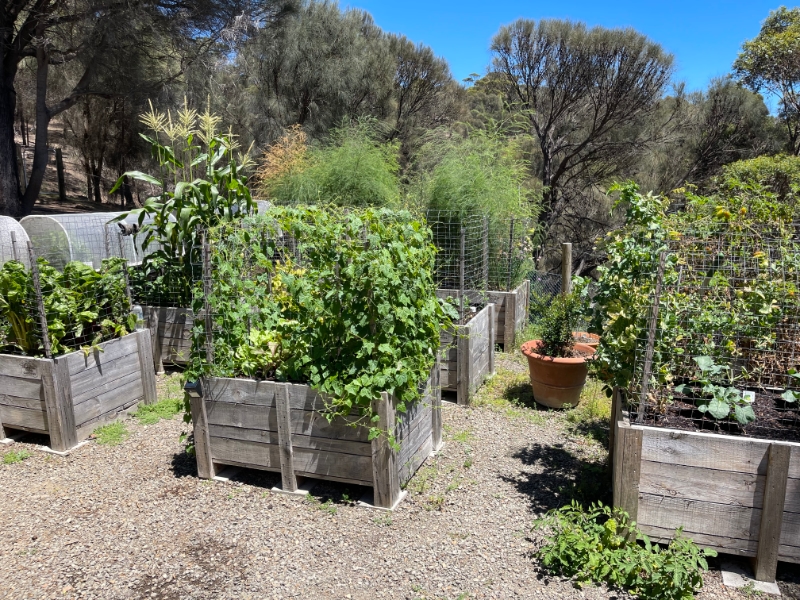
Whicking beds hard at worked with multitudes of different produce
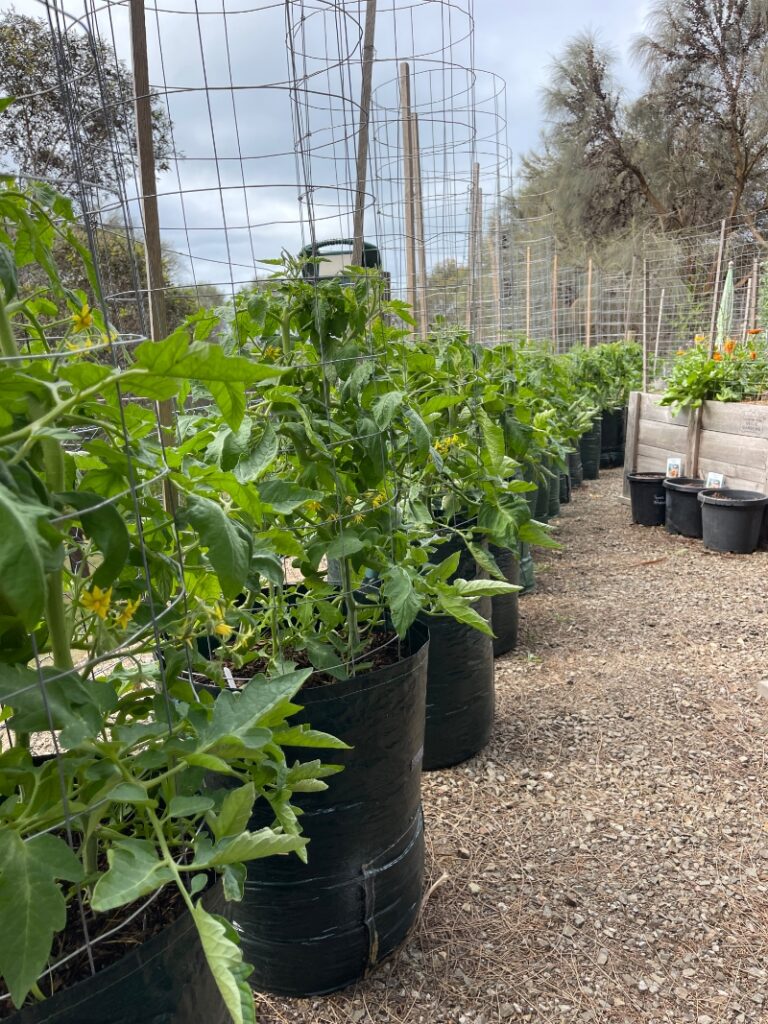
FIFTEEN VARIETIES OF HEIRLOOM TOMATOES WERE GROWN IN DIGGERS POTATO BAGS WITH A CIRCULAR MESH FRAME TO SELF-SUPPORT
David in the KITCHEN
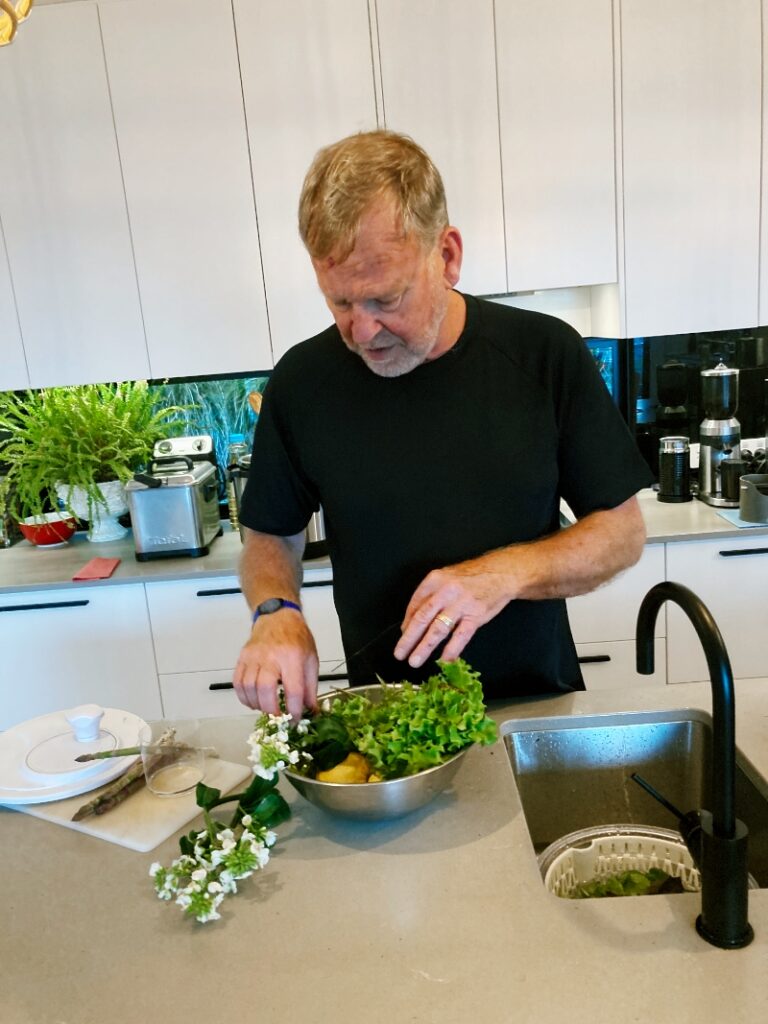
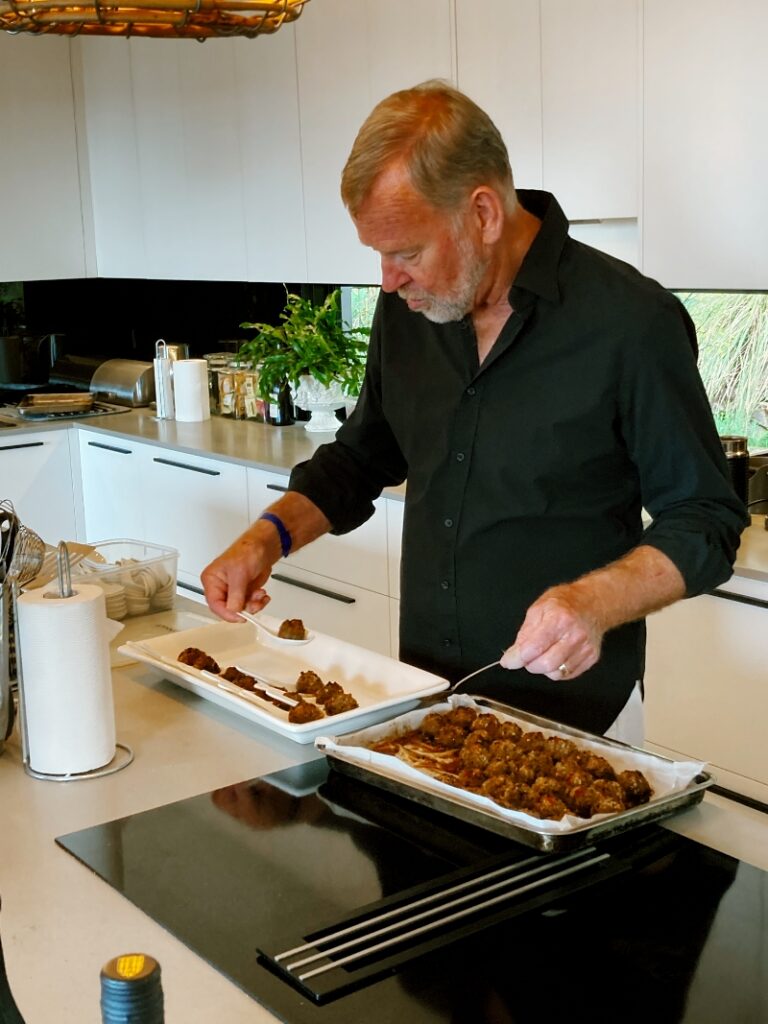
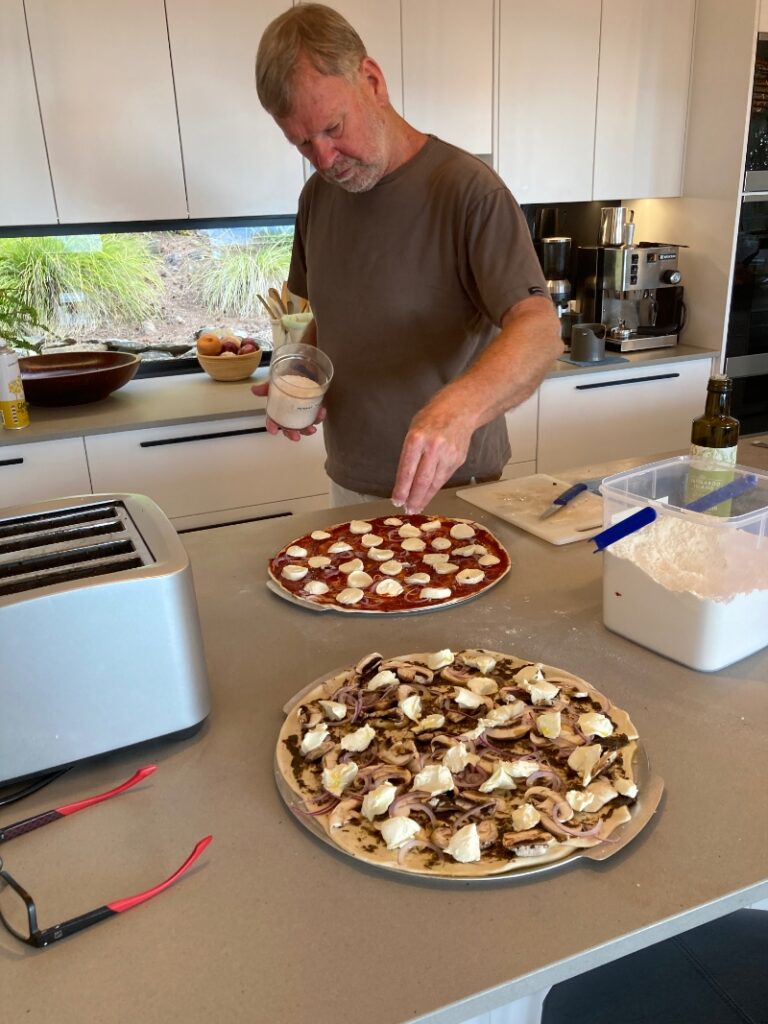
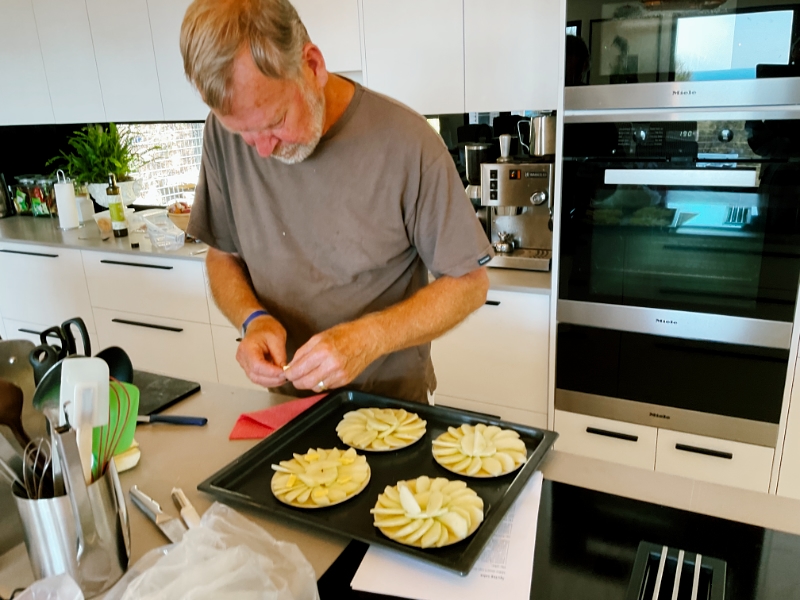
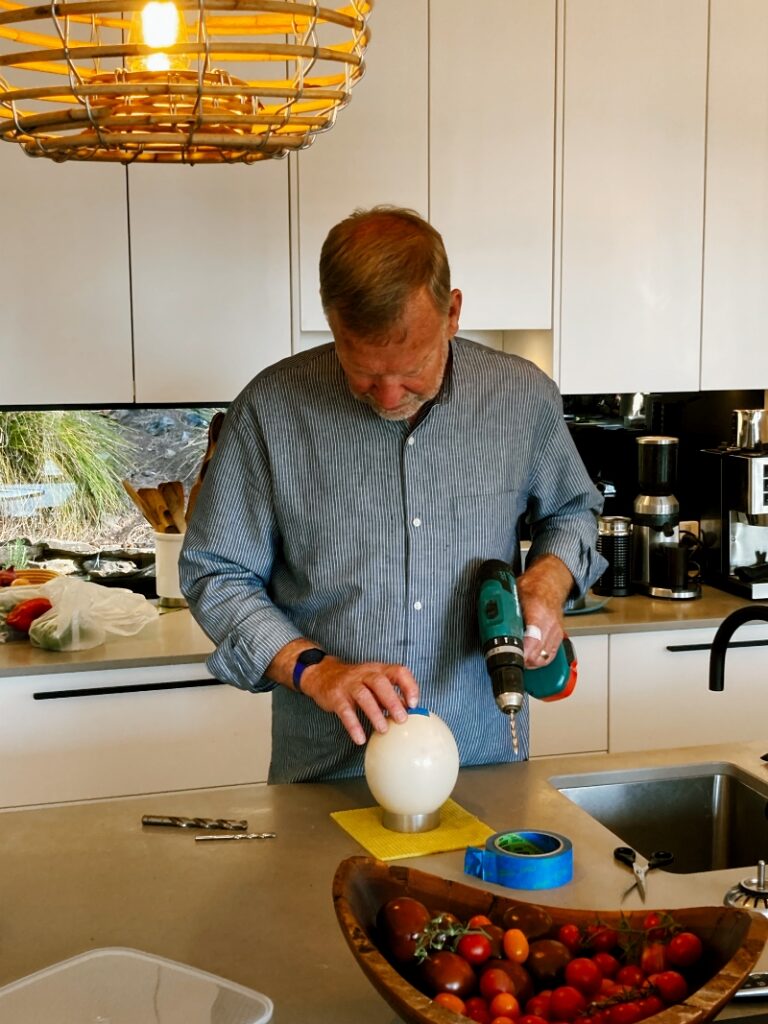
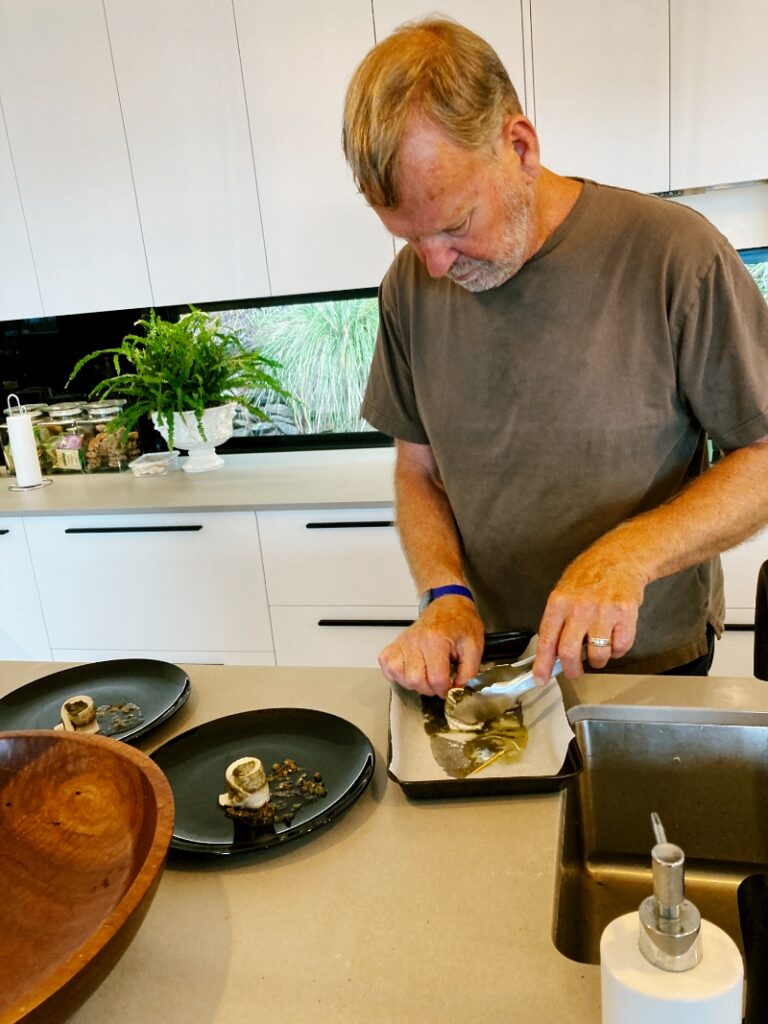
A low dry-stone w dry-stone wall defines the path from the gardens, and the resultant bed is perfect for small fruit trees and this summer it became the “zucchini walk”. David had dreams of creating a “Monet” pumpkin patch”, like the nasturtiums at Monet’s house at “Giverny”. The pumpkins however, had other ideas: and there, they just grew into one massive clump! Whilst we try to stick strictly to planting only indigenous natives to the areas that we are re-vegetating – we have relaxed that rule for the immediate house garden, and plant anything native that attracts the birdlife. There are many wrens, honeyeaters, pardalotes, silvereyes, robins, lorikeets, finches, and fan-tailed cuckoos that all join the larger Kangaroo Island ‘Grey Currawongs’ – in the numerous birdbaths around the garden.
The Kangaroo Island Glossy Black-Cockatoos can be heard munching on the casuarinas nuts daily: and at night, we hear K.I. Southern Boobooks calling. Like all gardens, it’s a “work in progress”! It gets a lot of tough love! We are lucky enough to have mains water: but heavy mulching with bean straw, plus the use of minimal drip irrigation to most of the house beds.
Most of the more recent work has been done in the past two to three years – so we look forward to watching the growth in the coming years.

JUST A SMALL SELECTION OF OUR 2024 TOMATO CROP….AT LEAST HALF OF THE CROP TURNED INTO SAUCE FOR THE WINTER MONTHS
The house now has two guest rooms and what was essentially the original house, is a wonderful large open plan living, dining and dream kitchen of any cook! The north-facing decks are our favourites places to sit and admire the gardens and views.
One of the best things done during the renovations, was installing a very large retractable sail over the main living room deck. It created the perfect “outside” room.
The building program also allowed for some major reorganisation of the garden. The block is on a very steep slope, with no flat land. The earthworks for the extension gave us much need “fill” in order to create a flat area for David’s much desired vegetable garden. Whilst the surface soil is good, the entire hill is mainly rock, black basalt and it’s impossible to dig a hole without a rock or stone appearing!
Due to the terrain and the earthworks, we were able to create a north-facing plateau for the vegetable garden and we have also been able to push the fences much further out, and so create a much larger “roo proof” area.
The plan had been to build our own wicking beds: but reality set in, and thankfully “Adelaide Hills Vegie Gardens” had exactly what we wanted! We also supplemented their beds with three “Vegepods”. We had purchased one of these, during Covid, and found them perfect for herbs and salad greens. The final layout is twelve beds, three ‘Vegepods’, and nine Adelaide Hills beds.
amongst the natives exotics
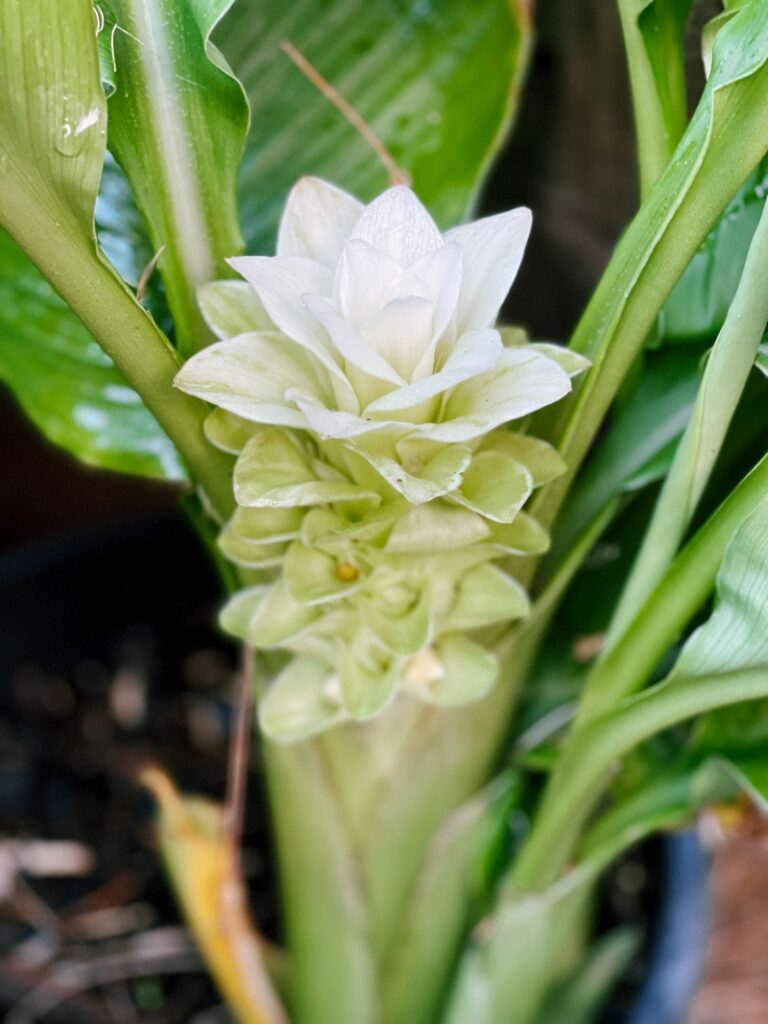
SO EXOTIC, TURMERIC FLOWERS
Add in literally tons of rock for dry stone walls in literally tons of rock for dry stone walls; and we have come up with a very simple but attractive landscape for the basis of our new gardens. The wicking beds are used for Asparagus, Chard, all the brassicas, corn, beans, peas, heirloom beets, leeks, sorrel, capsicums – plus plantings of flowers like calendula and nasturtiums to attract bees and for culinary use. 15 different varieties of tomatoes are planted in Diggers potato bags which have a round mesh collar attached to allow the plants to self-support. Plants like capers, turmeric & galangal are planted in pots around the garden. The mild climate and lack of frosts allows for tomatoes being planted in early September.
The lower garden is reached via a broad gravel path, created to allow the earthmoving equipment to prepare the area for the vegetable garden. It also gives the house some protection in case of bush fire.
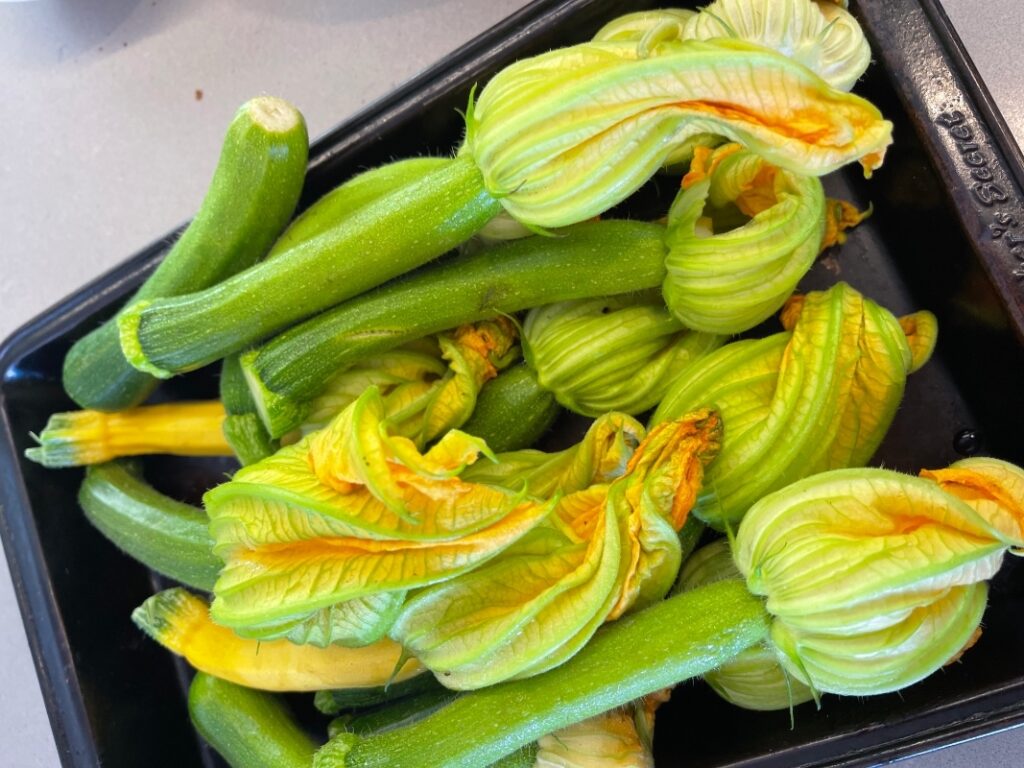
ABSOLUTE SEASONAL ABUNDANCE, BABY ZUCCHINIS AND ZUCCHINI FLOWERS
thorn park on the island
david's cooking has consistently
received the
highest accolades
One of my greatest joys in life is sitting around the table “breaking bread” with friends & guests.
Having an abundant and productive garden reinvigorates the art of creating dishes and menus that are truly fresh and seasonal.
David Hay co-owner with Michael Speers
ONE OF MY GREATEST JOYS IS THE BREAKING OF BREAD WITH FRIENDS AND GUESTS
Thorn Park
on the island
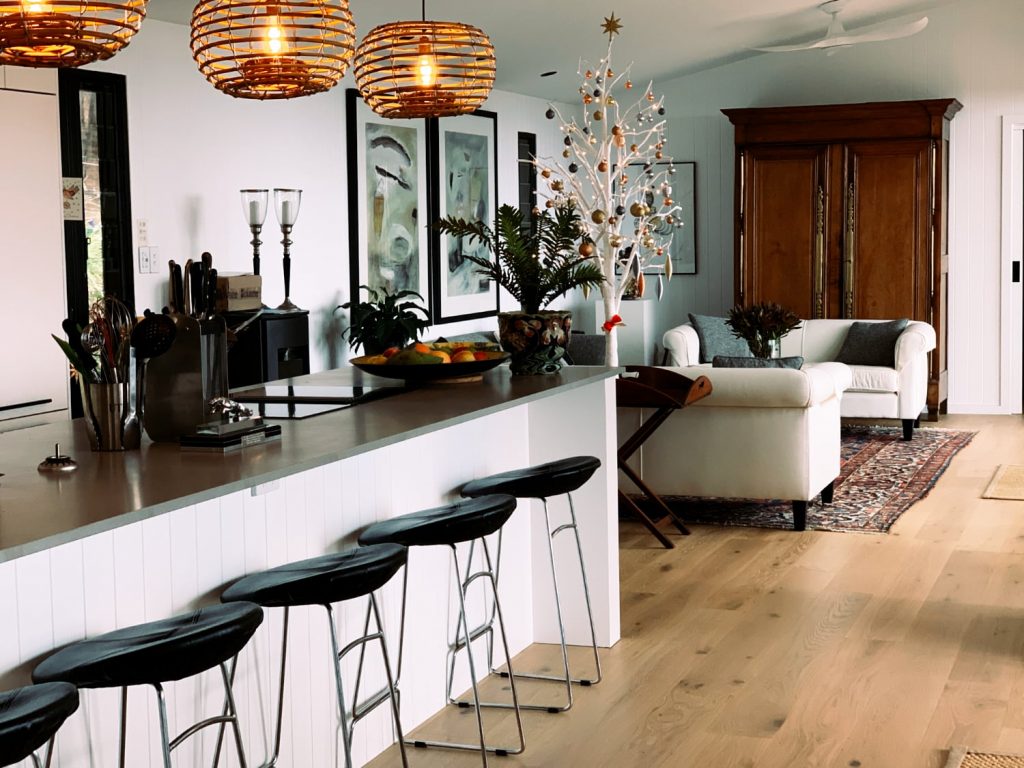
LOVE WATCHING A COOK WORK?
subscribe
join our newsletter
Our newsletters are occasional; keeping you up to date with local events you might enjoy attending and news about our properties.

e stay@thornpark.com.au
telephone +61 8 8553 1367
postal PO Box 696, PENNESHAW, South Australia 5222
address 50 Wright Street, Penneshaw, Kangaroo Island, South Australia 5222
web site last updated June 5, 2024
copyright © text and images unless otherwise stated 2024 Thorn Park – PRIVACY